Sonos Play:5 review (2015): A generational leap forward
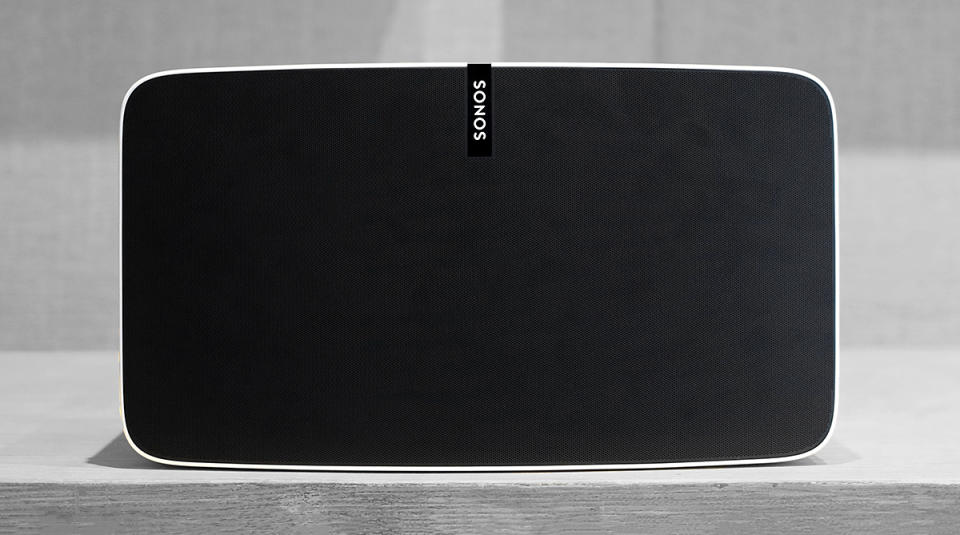
The all-new Sonos Play:5 is the company's first major hardware revision; a fresh flagship for its fleet of WiFi-enabled speakers. Sonos' products have always been praised for their design and functionality, but not necessarily their sound quality or value. The new Play:5 definitely isn't cheap: At $499, it's actually $100 more than the original. But the old Play:5 was the company's first attempt at building a speaker, and although it sounds okay, Sonos has come a long way in the six years since its release. This time around, Sonos finally created a product that looks and sounds as good as its price tag. But it's still not for everyone.
The Sonos proposition
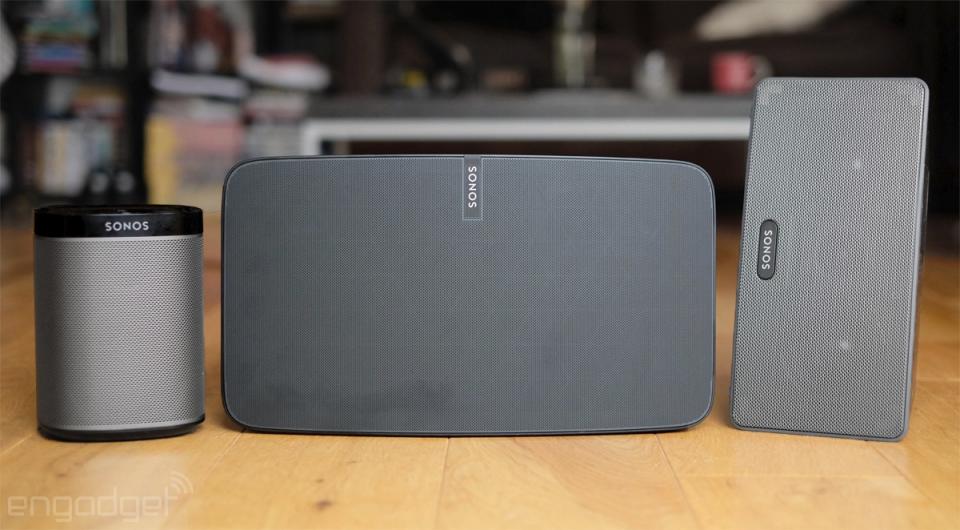
From left to right: the Play:1, Play:5 and Play:3.
If you're new to Sonos, it's a multi-room speaker system that lets you stream audio from a number of web sources or from local storage. The list of services is comprehensive, but not exhaustive. Subscription-based streaming companies like Spotify, Rdio, Deezer, and Tidal are all there, as are music lockers and one-off purchase shops like Amazon Music or 7Digital. In-between options like Google Play Music and Groove are present, and alternative or radio services like Bandcamp, 22tracks, SoundCloud, TuneIn and Radionomy are also supported. For the Play:5 specifically, you can also hook up pretty much anything with a headphone port to the system.
All this support comes through one place: the Sonos controller app for PC, Mac, iOS and Android, which does its best to put whatever services you want into a single, coherent interface. From the app, you can search all your services, browse and create playlists and choose where your music will play. For hardware management the app is great -- it's simple to navigate, and you'll find it easy to add new speakers, and create speaker zones and groups, as well as tweak volume and EQ settings. For actually playing music, though, it's a mixed bag.
Generally things work well enough, but the experience of managing music through Sonos' application is always second-best to just going directly through your streaming service's app. While playlists and other organizational tools port over nicely, searching for new tracks is a hassle. There's just no intelligence to it. Say I'm looking for the song "Undercover" from the Solos-Duos album by Pierre Van Dormael and Hervé Samb. Spotify's app is smart enough to read me typing "samb undercover" and suggest the correct song before I'm done writing the second word. Sonos, on the other hand, only lets you search by artist, track or album, and will fail to recognize any combination of these. If you're looking for a song with an indistinct name, you're going to have a hard time finding it without digging through album after album. The song I just referenced is the 41st search result for the word "undercover," in case you were wondering.
Sonos has its issues, but does a great job of pulling multiple services into a single app.
In spite of its imperfections, the Sonos controller does a commendable job of pulling multiple services into a single place. The search issues are a real shame, as the app is great for mixing and matching multiple services. Being able to build a playlist that effortlessly pulls from, for example, Spotify, SoundCloud, Deezer and my PC is a fairly unique selling point, especially as SoundCloud is home to a lot of exclusives and eclectic stuff that doesn't typically make its way to other streaming services.
The other benefit of Sonos' system is that there's no limit on the number of users that can control it. Anyone connected to the same WiFi network can get involved by downloading the app, making it a great system for parties and get-togethers. You can also connect multiple accounts from the same service, so if you have a large family you can each, for example, have your own Spotify playlists and favorites syncing.
Hardware
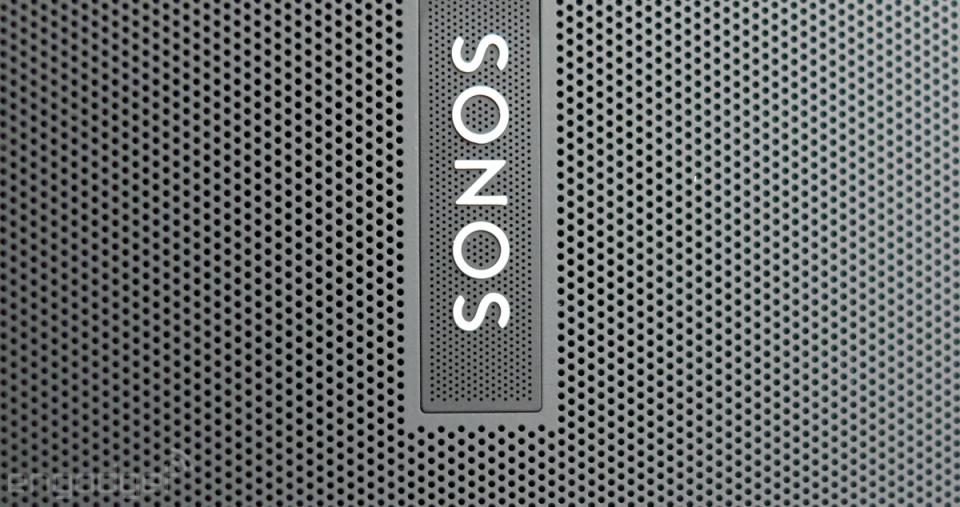
The Sonos logo is surrounded by precision-drilled holes that stop it blocking sound from the tweeter behind it.
I've already touched on the Play:5's lofty position in Sonos' broader lineup, but it's worth looking at the entire selection in a bit more detail. At the bottom of the range is the Play:1 at $199. The mid-range option is the Play:3 at $299, while the Play:5 is considerably more at $499. The Play:1 is a tiny thing, offering a single tweeter and mid-woofer, each with its own amplifier. The Play:3 keeps the single tweeter, but replaces the mid-woofer with a pair of mid-range drivers (all independently amplified) and a passive bass radiator. For the Play:5, Sonos goes all out, with three tweeters (one central and two side-firing), three dedicated mid-woofers and, in case you didn't notice the pattern, an amplifier for each.
The Play:5's six speakers are all neatly enclosed in a subdued, but nonetheless beautiful enclosure. It's a far sleeker object than the Play:3 and the previous-generation Play:5, with a gentle curve to its front and a mixture of rounded and sharp edges forming pleasing, clean lines when viewed from any angle. There's barely anything to catch the eye, nothing to distract from its overall form. Even the physical buttons have been replaced in favor of capacitive keys that also accept swipes for things like skipping tracks. What might not be perceivable in the photos accompanying this review is the precision of the engineering here. Seemingly no detail is overlooked. Case in point: Sonos is one of very few companies that designs entirely custom power plugs at both ends for no reason other than it wants them to look and feel good.
If you like colorful speakers, then look elsewhere. Sonos has but two options: gray-on-black or black-on-white, both finished in a matte polycarbonate. I'm a huge fan of the latter, but sadly I didn't get to choose my review units. Although it's still a beautiful object, the gray-on-black version just fades away into the background. Most people would probably appreciate that, but I wanted the speakers to be a statement, a conversation piece, and the black-on-white version is really striking.
Getting started
When you first plug in a Sonos, you can use a phone, tablet, PC or Mac to get started. Setup is simple no matter the device, but it works best with iOS. When using an iPhone, iPad or iPod Touch, after pairing -- which involves pressing a sync button on the speaker and not much else -- you'll be invited to use a new Sonos feature called Trueplay to tune the Play:5. We've written about this iOS-only feature in detail, but to catch you up, it essentially plays a seemingly random selection of sounds and uses your phone's or tablet's microphone to test your room's acoustics and your speaker positioning. It'll then modify the speaker output to best suit its surroundings. The idea is not to create a single sweet spot, but to tune your speaker for the entire room.
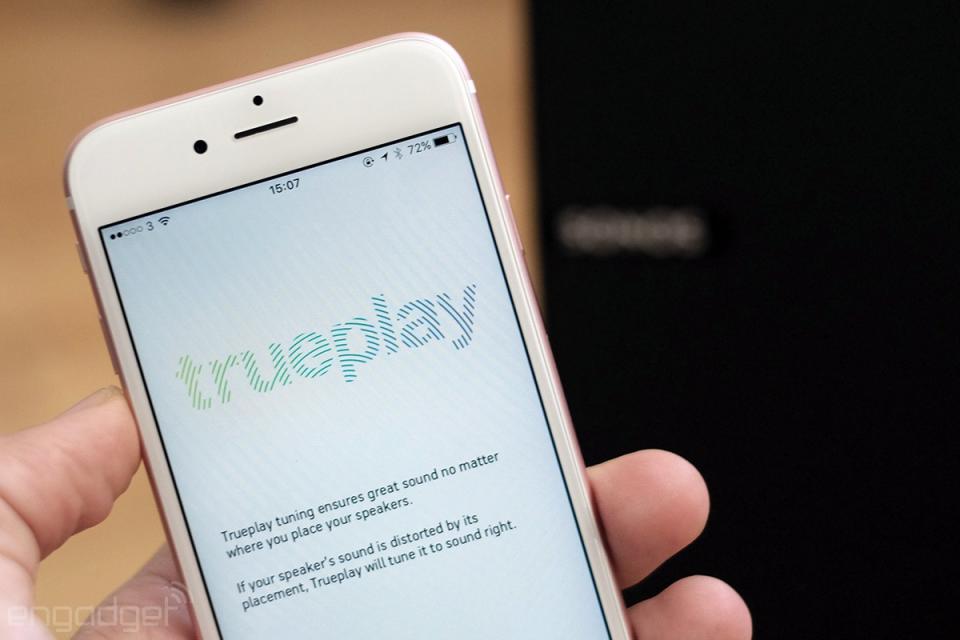
So here's the thing about Trueplay. It's a simple process to go through, but it requires some thought. The app shows a little video guiding you on how to wave your device in the correct manner and displays a lady wandering all around a room. In practice, this may not be the best way to go about things. I've tested the speaker in multiple rooms of my house, and in most locations the general wandering-and-waving technique worked well, but there were a couple of situations where it did not.
In my bedroom/office where I do most of my music listening, I have the speaker on a bedside table, angled to fire over my bed directly at my desk on the other side of my room. With this setup, following Sonos' instructions and wandering the entire room left the Play:5 tuned completely wrong, with very weak bass notes and overly loud trebles. The second time I ran the tuning, I stayed around my desk and bed, ignoring the rest of the room, and was rewarded with a near-perfectly tuned speaker.
Sound quality
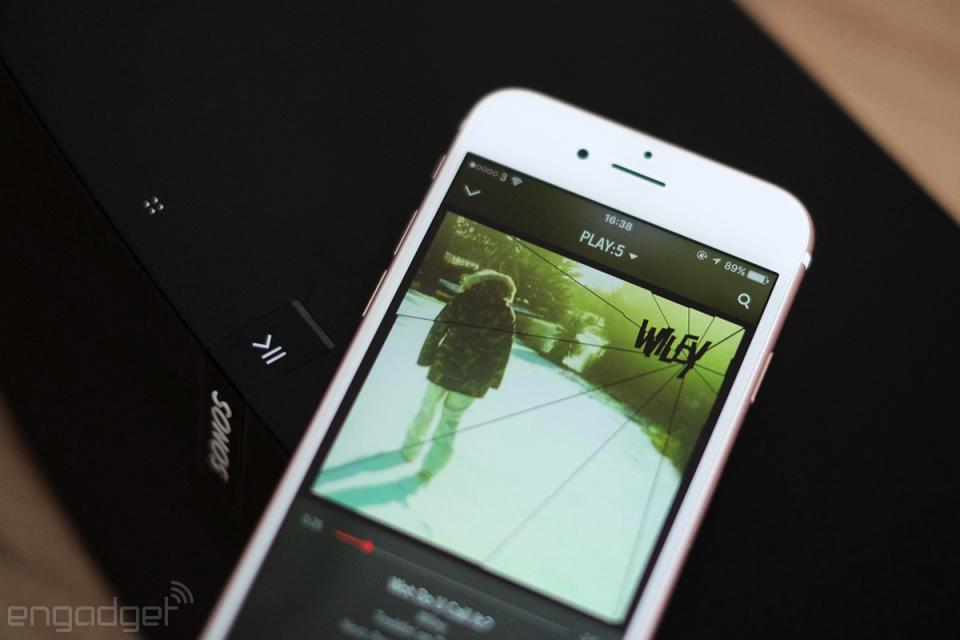
Trueplay does add a real clarity to music by removing or reducing frequencies -- especially low notes -- that reverberate oddly due to obstructions or room acoustics. But it's not perfect. Tuning issues aside, it's a bit overzealous with bass reduction, which can ruin the balance of tracks with a strong focus on the low end. Overall it's worth the trade-off, but I'd like an easier way to turn it on or off within the app. Right now you have to dig through the settings menu to find the correct checkbox, but I'd like to see a button on the playback screen instead. Sonos already has audio-setting shortcuts like this for its Playbar, so there's no reason it couldn't do the same here.
The bass issue introduced by Trueplay has actually been a long-term complaint about Sonos. The Play:5, like the Play:1 and Play:3, has a sealed speaker system with no port to draw or release air. This typically results in bass that's crisper, but less boomy than ported systems. The effect isn't noticeable when you're blasting music out at, say, 70 percent of max volume, but listen at lower levels and things are a little bass-shy. To combat this, there's a "loudness" setting in the EQ that helps music sound more bass-heavy at lower volumes. I routinely have this switched on, as I don't tend to blast music ridiculously loud.
These are fairly small issues, and although I'm no audiophile I do accept I'm more uppity about sound quality than most. The Play:5, even with its niggles, sounds fantastic across a broad range of music. An hour-long selection of tracks I used to test the speakers is embedded on the right -- I actually used Deezer Elite for the audio testing, but Spotify is there for your convenience. Anyway, this is easily the best speaker that Sonos has ever made. It blows every smart speaker I've ever used out of the water, and it truly competes with non-smart options in the same price range.
Audio quality is always a difficult thing to judge. There's a character to each pair of headphones and speakers that can't be seen on a spec sheet or a frequency-response graph. Beyond the quantifiable, you just have taste, which is why there are $1,000 headphones that I dislike, and $35 pairs that I love. I don't actually love the Sonos gear I currently own (two Play:1s, two Play:3s and a Playbar). I invested in Sonos for the multi-room experience, and the two Play:3s that I use daily deliver an adequate sound, but always feel a little limp and lifeless. Using even a single Play:5 in their stead has been a surprisingly pleasant experience. It's better balanced, clearer and far punchier toward the low end. Stereo separation isn't perfect, but you can't expect a single-box setup to totally isolate the left and right channel without it sounding unnatural. Overall, it's a stellar speaker, and one I suspect will win over many naysayers.
The Play:5 truly competes with non-smart options in the same price range.
I can listen to the same song on different headphones, and it'll sound distinct on each. I notice a particular mid-range note in one pair of cans -- a very "balanced" pair of AKGs -- that'll be entirely missing in my daily "out-and-about" headphones, which in turn will highlight some digital noise added to a bass note. Neither is necessarily better or worse; they're just... different. I have these little revelations daily with my admittedly expensive headphones, but never with my Play:3s, which, all told, set me back $600. The Play:5, however, joins the conversation. I am noticing new things about tracks on a daily basis, and it feels great. To be clear, this is something I'd expect from a $499 speaker. But it's not something I necessarily expected from a $499 Sonos.
Two's company
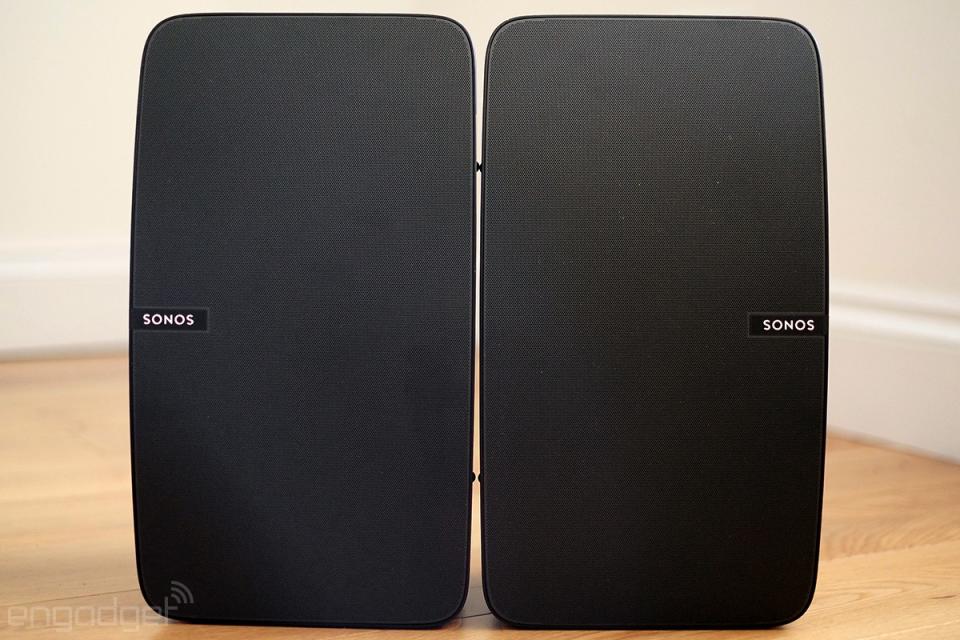
Those are the broad strokes; now the details. I've mainly focused on the experience provided by a single Play:5, but a pair of the speakers can, like the Play:3 and Play:1, be set up to work as a left- or right-channel speaker. Pairing is simple: Add the second speaker through the app; let Sonos know if it's the right or left channel; and then go through the Trueplay process. Once you have two paired, the experience is truly impressive.
Even after a short hour-long demo last month, I was already sold on just how good the Play:5s sound when stereo paired. In the week or so I've spent with them in my home, I've been able to listen to a broad range of tracks I know well, and I'm even more convinced of their merits. There are actually two setup configurations for you to try out that will result in a distinct sound. There's an orientation sensor inside each, and the software will power different drivers depending on which positioning you choose. If you place the speakers vertically, you'll get quite intense separation, but more targeted at a "sweet spot" in your room. Turn them horizontal, and the side-firing tweeters provide nicely separated stereo sound to a surprisingly broad area. And I mean "surprising" -- I can be sitting directly in front of the left-channel speaker and still hear the individual channels.
Because I generally listen to music alone, the vertical arrangement makes the most sense for me. But it's really useful to have the option to just flip the Play:5s on their sides, have the speakers detect that and let them modify their output to play music to a larger group of people.
Line-in and future-proofing
The Play:5 also has an option unique within the Sonos lineup: a line-in port. With a 3.5mm cable, you can play music from anything with a line-out or headphone port. Sonos seems almost begrudged to hold this port over from the last generation, but it adds a lot of functionality to the overall experience, as you can stream the line-in audio to any speaker in your network with very little latency.
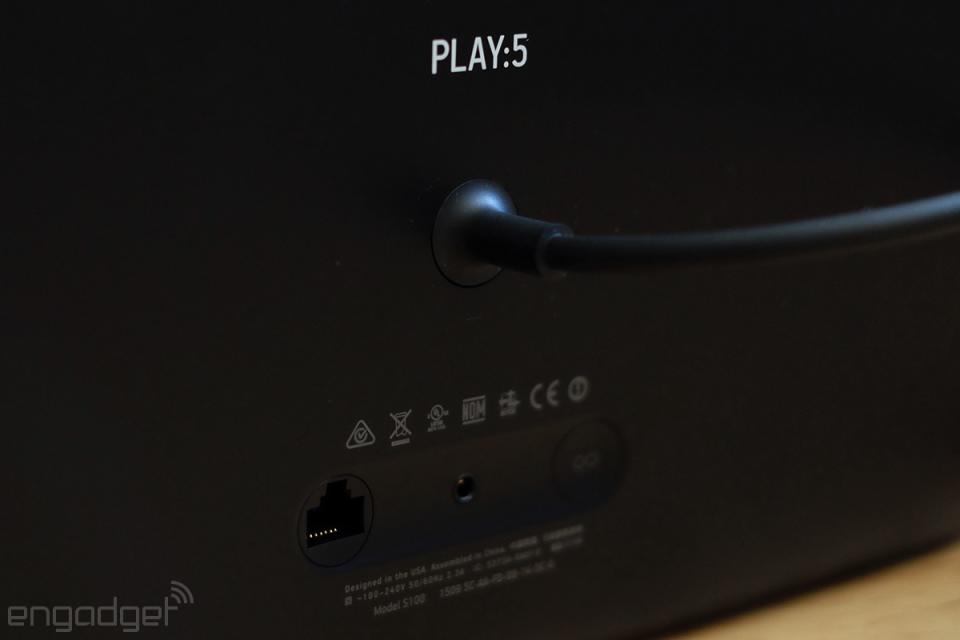
During part of my testing, I had the Play:5 on my desk and used it as a PC speaker. Being able to play my PC's audio wholesale throughout the house is useful, especially if I'm listening to a video podcast or watching a football game in my browser and need to head to the kitchen to grab some food. There's a tiny bit of lag, which it seems is a necessity to sync the audio across the entire house. It's not enough to make lip syncing a huge problem for movies, and games worked well enough also. So, although Sonos probably doesn't want you to use its flagship speaker to blast out YouTube clips, the Play:5 is more than capable.
Software updates are frequent and often very useful.
One thing I haven't mentioned yet is something that's not really possible to review, but is definitely worth knowing. Sonos regularly updates its speakers and software with new features and functionality. This covers not only basic stuff like adding new streaming services -- for the record, Apple Music support is coming soon -- but also things like Trueplay tuning, which was announced alongside the Play:5, but also works with the Play:3, Play:1 and the previous-gen Play:5. Perhaps the most notable update in recent memory meant that Sonos no longer needed to be plugged into your network to function properly. Prior to the update, at least one piece of equipment required an Ethernet connection to your router.
The Play:5 actually has some additional hardware that's not active at launch: a microphone. It could be used for automatically tuning the speaker in the future, or perhaps for voice controls. It's impossible to know what's around the corner for this particular speaker -- Sonos says it's actively exploring the possibilities -- but you can at least know that the company will support the Play:5 for a long time to come.
Remote constraints
Back to the present, and Sonos' vision for its products is that they are solely controlled through its apps. While I don't think the controller app is bad, I do find it a little limiting at times. If all I want to do is skip a track, and the speaker is on the other side of the room, I have no options but to either walk over to the speaker or pull out my phone. Neither of those is the most arduous task, I know, but this is a $499 product. There's a $10 invention that Sonos could very easily pack in with it: a remote control.
I'm primed and ready for Sonos enthusiasts to tell me that I'm missing the point, but the fact remains that a remote would be super useful. The company used to sell a complex controller replete with a touchscreen, which was superseded by its own app. When I talk about remotes, though, I mean something similar to an Apple Remote that would offer a simple way to control volume and track selection without the need to pull out your phone and open an app.
The competition
It should be clear by now that I'm a firm believer in Sonos as a platform, and even more so in the Play:5 as a standalone product. As someone who's already invested almost $2,000 in Sonos gear, I obviously don't represent the typical consumer. Should you get a Play:5? I can't really give you a one-word answer. If you've got a non-smart home audio setup that you're looking to replace, one or two Play:5s could be perfect for you, assuming the asking price works with your budget.
If you're new to Sonos and to the idea of spending lots of money on home audio gear, the $499/$998 price tag is probably enough to scare you away. I have friends and colleagues who are happy with a couple of Play:1s dotted around their apartments, and you might be the same. You could even buy both a Play:1 and a Play:3 and still save a dollar over the asking price of the new Play:5, so you really need to care about the differences among Sonos' offerings.
Replacing old hardware with Sonos speakers might be overkill, though, especially if you're happy with the sound quality. You can add some basic casting functionality to regular speakers for $35 with Chromecast Audio, or if you want the full range of Sonos functionality, you can stump up $349 for the company's Connect add-on. Connect plugs into your amplifier or hi-fi via RCA cables, and you always have the option to add some Sonos speakers elsewhere in your home to start building out a multi-room system at a later date.
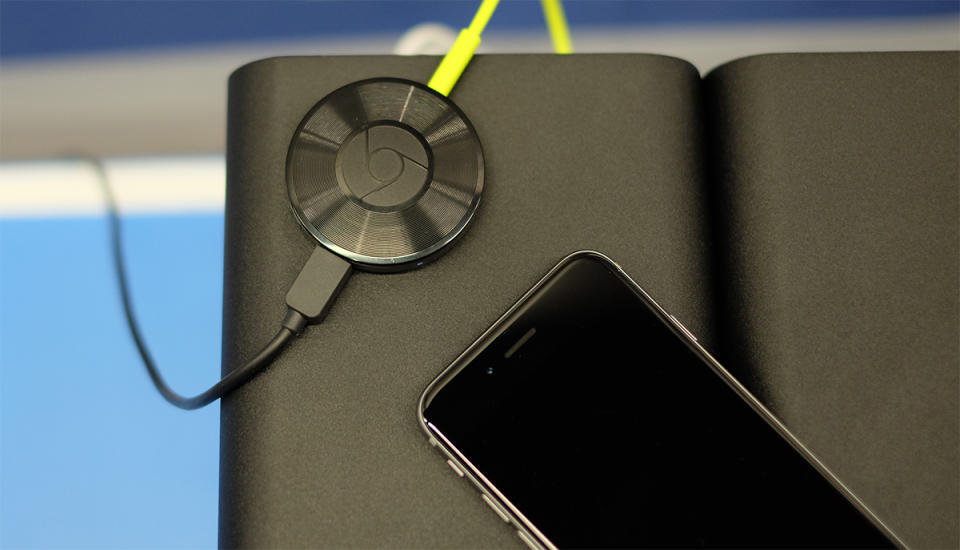
The Chromecast Audio makes regular speakers smart for $35.
There are a growing number of competing multi-room systems to consider from the likes of LG, Samsung, Bose and others. Many of these support Google Cast, which works similarly to Chromecast for your TV and lets you send music from your phone to the speakers. I've tried all of the above companies' gear, and regret to report that none of them get close to Sonos' previous-generation speakers, let alone the new Play:5, for sound quality.
Rival WiFi speakers can't come close to Sonos, but Chromecast offers a lot for a fraction of the cost.
With Chromecast able to add smart functionality to any pair of speakers -- and multi-room support coming soon -- buying into a company-specific system that isn't Sonos doesn't make a lot of sense right now. Those on a super-tight budget are better off finding a non-smart speaker they're happy with and adding the $35 Chromecast Audio dongle.
If you've got your heart set on a Sonos, but are undecided about which to get, I'd recommend finding a stop along the Play:5 demo tour, a brick-and-mortar store, or an online shop with a bulletproof returns policy; really just any way you can find to spend some time with the different options. Just bear in mind that the Play:3 is probably due for an overhaul sometime soon -- it's now ancient compared to the rest of the lineup.
Wrap-up
As for me? I'll definitely (after an unspecified period of counting coins) be picking up a pair of Play:5s to round off my home audio setup. I was very pleased to see Sonos create a (comparably) budget speaker in the form of the Play:1, but it's great to see the company trying to push the envelope on sound quality instead of just lowering the price of entry. The Play:5 is a big leap forward for Sonos, finally setting up the company not just as a disruptive tech startup, but also as a bona fide creator of quality speakers. Let's hope the improvements it's made here trickle down to the second-generation Play:3.












